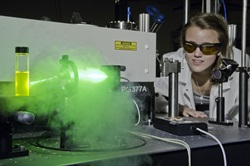
CAMDEN — This summer, Rutgers–Camden students are doing some very big research on the smallest possible scale.
A team of undergraduates is creating nanoparticles from different materials — such as copper, gold, and silver — using laser processing to seek out new avenues for material interaction and new applications for the nanoparticles they’re generating.
“We’re interested in making nanoparticles from different materials for basic research in a variety of fields,” says Daniel Bubb, a professor and chair of the Department of Physics at Rutgers–Camden. “The future is in nanomanufacturing, so we’re looking for a clean way to make relatively small amounts of nanoparticles that could be used in biomedical research, materials research, or research in other areas.”
The ongoing project is being supported by a three-year National Science Foundation grant totaling $366,735. This summer, six students are working on the project with Bubb and Sean O’Malley, an assistant professor of physics at Rutgers–Camden.
“We like to involve as many students we can to get them into the research,” O’Malley says. “Many of these students will get jobs after they graduate and some will move on to graduate school. Having had this experience, the students are much more prepared for the next step than others who don’t have the opportunity to do this kind of research.”
In Bubb’s lab, the students are making nanoparticles from the metals through a process called laser ablation, which is removing material from a solid or liquid surface by irradiating it with a laser beam.
"The future is in nanomanufacturing."
Bubb says working with nanoparticles has come to the forefront of scientific research because the tiny particles have a wide variety of potential applications. The ability to manipulate molecules on the nanoscale could allow scientists to build materials that are many times stronger and lighter than those used in engineering today.
“I’m very interested in the application of nanoparticles and in this lab, everything is so hands on,” says Alex Kazantsev, a sophomore engineering major from Cherry Hill. “We’re taking everything we’ve learned in the classroom and applying it here.”
J.J. Naddeo, a junior from Marlton majoring in both physics and finance, started working on the project in Bubb’s lab in June by making copper nanoparticles before moving on to gold and silver nanoparticle research.
“It’s just like having on-the-job training,” Naddeo says. “I didn’t know much about nanoparticles before I came to Rutgers–Camden, but it’s at the forefront of science today. It takes a couple of weeks to get your feet under you, but it’s very interesting. The hope is to discover something promising from our work here.”
Renae Gannon, a sophomore engineering major from West Deptford, adds, “Metals are actually really interesting to study and I think we can make discoveries by looking at the properties of the metals we’re working with.”
The research funded as a collaborative effort with a research team from the University of Virginia, which performs molecular dynamics simulation of laser ablation. The collaboration includes frequent travel between the two research groups to review progress, which Bubb says is beneficial for the Rutgers–Camden undergraduate students working on the project.
“It’s nice to have a computational group at the University of Virginia and an experimental group at Rutgers–Camden working on the same thing. We really want to really build up what our capabilities are here and what kinds of problems we can attack,” Bubb says.
“At the same time, we want our students to have skills that are marketable,” he explains. “Part of their training is learning how to be part of a team and solve problems. I don’t know how many of these students are going to be doing laser ablation research in the future, but just learning how to do research and attack a problem is the most important goal.”